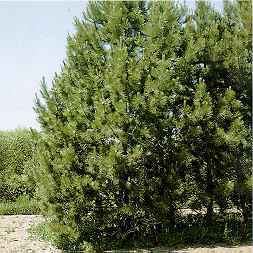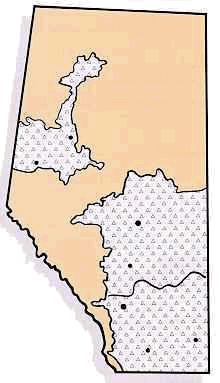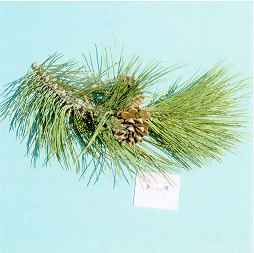| | Plant characteristics | Site preference | Hardiness | Uses | Problems | Diseases and insects | Pruning
.

Scientific Name: Pinus sylvestris L.
Plant Characteristics
Scots pine is native to Europe and Russia. It was introduced in America by early settlers. It is suited to a wide range of locations in Alberta.
This is a medium-large tree, typically pyramidal when young, becoming more rounded and open with age. Plantings are often easily recognized because of the distinctive copper-orange bark of the upper trunk and large branches of a mature tree. The bark peels.
Scots pine can live from 50 to 100 years, with a growth rate of 30 to 90 cm (12 to 40 in.) a year.
Scots pine may reach a height of 25 m (80 ft) with a spread of 6 m (20 ft) in a forest environment but 12m (40 ft) is more usual on the prairies. Scots pine is a relatively fast growing tree.
Leaves - Needle-shaped, in bundles of 2, 3 to 7 cm (1 to 3 in.) long, twisted or spiralled, blue - green in colour, abruptly pointed.
Cones - Short stalked, 3 to 7 cm (1 to 3 in.) long, roundish in shape, dull tawny yellow. Winged seeds are produced, and released before cones drop to the ground. Cones take two years to mature.
Site Preference
It is well adapted to dry sites, particularly sandy soils, but can be found on a wide range of soil types. Generally not tolerant of saline soils.
Scots pine can survive drought conditions. It has a wide range of moisture requirements.
Prefers full sun, intolerant to shade.
Hardiness
Northern strains of Scots pine are winter hardy, but others have a tendency to winter brown.


Uses
Usually used as an inside row of a farmstead belt where it can be protected by the outer deciduous row. In a shelterbelt they can be planted 2 to 4 m (6 to 13 ft) between plants in the row, and 5 to 8 m (17 to 26 ft) away from other rows. In addition it is often used as a specimen tree in protected sites. The tree is of limited value for wildlife, although it does provide thermal cover in winter. Younger trees may be browsed by white-tail and mule deer.
Problems
Small rodents, such as porcupines, like Scots pine.
Diseases and Insects
Pine-needle scale may occasionally be severe in some areas. The pine bark beetles occasionally infest pines in the southwest area of the province.
Pruning
Pruning is not required, unless it has a double leader. If a leader is not present, a leader will have to be trained.
.

Shelterbelts Varieties for Alberta provides information on a number of other trees and shrubs than may be suitable for shelterbelts.
Visit our website directory for the Reforestation Woodlot Listings.
|
|